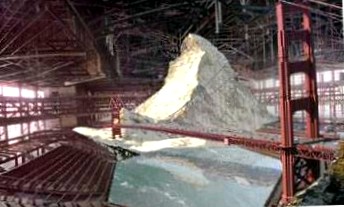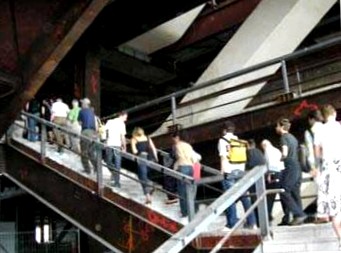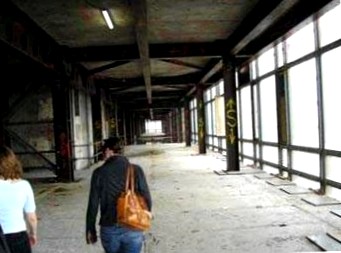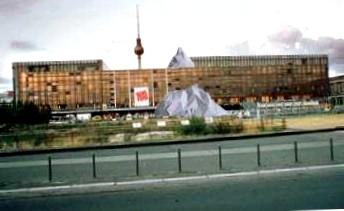Projection surface for ideas and visions
Climbing through the berlin palace of the republic
Climbing in the middle of berlin, on a white hill directly at the schlossplatz, which rises out of the ruins of the palace of the republic? Before the last crude symbol of the gdr state is torn down this year, artists are taking over the direction there. In doing so, they are once again demonstrating an alternative to demolition and a possible use for the ruined palace, which in recent years has gained cult status as a venue for events.
The palace on schlossplatz. Photo: david baltzer
The project people palace – the mountain makes the building for the last time of the 4. Until 26. August for visitors. Along with 35 other artists, the architectural group raumlabor planned and built a walkable mountain in the center of the palace. Hiking trails crisscrossed the ruins. The tour is planned less as physical exercise than as an excursion into the present and history of the building, into a craggy concrete massif.
A cool breeze provides an alpine touch in the shady foyer of the palace, while outside the sun heats berlin up to over 30 degrees celsius. The artificial mountain grows up to a height of 44 meters and is supposed to protrude from the roof by 12 meters. A structure with a volume of 10.000 cubic meters, over which 5.000 square meters of special foil. From above it looks like a gigantic igloo. The summit looks like the matterhorn. "Volkspalast – der berg" is a walk-through and recorded spatial installation with performances, exhibitions and tours that provide "sensational insights into the building structure" of the palace ruins, promises artistic director amelie deuflhard.

Mount eventerest in the rough hall. Installation: raumlabor berlin
But why do you need a mountain? For benjamin foerster-baldenius of the architects’ group raumlabor, who initiated the project as the "artistic director of the mountain," this is a difficult question to answer. In its own way, the mountain creates a tabula rasa for the discussion about the schlossplatz, on which the city palace is to be rebuilt after the palace is demolished. Here the mountain offers itself as a projection surface for ideas and visions. As a place of longing, where thoughts can wander, to imagine berlin’s most central square even without preuben residence. Thus, the mountain as a space turned contradiction questions the function of the place: what else should go here??

Tour through the ruin. Photo: jorg brause
Visitors can meditate on this question on a circular walk through the concrete massif. There is not much left of the berlin prestige building of the gdr. When the asbestos removal was completed in 2003, a rusty steel skeleton and a lot of bare concrete remained, in which almost everything was removed except for the load-bearing walls and stairs. The whole a wide-ranging, gloomy emptiness.
Even though the people mocked the palace, which was opened in 1976, as "erich’s lamp store", the building enjoyed great popularity. Not only the people’s chamber resided in the house and not only official honors of the ‘working people’ were celebrated.
Here, the gdr television ballet danced in the event hall, which was a multi-functional wonder with all conceivable technical finesses. An ice skating show could also start there from time to time. The numerous restaurants, cafes and bars were open to the burgers. With 15.000 visitors a day, it was the most visited place in the center of east berlin. Somehow also a people’s house, where some fell in love on bales and then celebrated his wedding. In 1990 the lights went out.

Tour through the ruins. Photo: jorg brause
But 13 years later, visitors flocked again to the shell, where hardly any traces of its past remain. Thus, a tour becomes a search movement of memory and, with the mountain action, also for the future. When visitors cross the event hall on a bridge at a height of four meters, of which only the wooden skeleton of the rows of seats still stands, they are offered a panoramic view of the summit of the palace mountain, "mount eventerest".
A sound installation by paul plamper and julian kamphausen plays around the aisle, creating a connection between architecture and memory. They mix sounds from nature with stories of mountaineers, with recordings of original sessions of the parliament of the gdr, the cultural program of the palace, and they make a connection to the present with the berlin banking scandal.
But the joyful music is quickly forgotten when the walkers reach the foyer on a plateau in the auben gallery: not an idyllic location. There the exhibition "demolition and then? X ideen fur den berliner schlossplatz" the walkers with visions of the past and future of the palace. The demolition of the ruins is certain, but the future of the resulting empty space is still open. The reconstruction of the city palace has been decided by the bundestag. But because of the billion-dollar investment, there is still hope that something else could be built.

The mountain breaks through the palace. Assembly: space laboratory
Or stand still? At first glance, everything seems possible, including a new use for the palace. For example, as a miniature golf course, because with its many open levels there is plenty of space for this, free from the influence of weather conditions. At least that’s what viennese architect michael zinganel and his colleagues are proposing.
Past such thought-provoking walks, visitors then continue to wander over the mountain area populated by artists. Not only the building inspired the artists to routes. The mountain not only fills a void, it becomes a theme itself. After the tour, hikers must choose whether to continue on the path of pilgrims, philosophers or mountaineers. For those who set out as philosophers or pilgrims, theory and contemplation are on the agenda. The palace becomes a three-story agora, where, for example, hannah hurtzig and moritz rinke put on a "berlinum" about the disappearance of the palace.
Eight international architecture bureaus staged the mountaineer’s path as an adventure trail on which they make use of the building’s adversities. There you have to climb to cross ravines that gape into the concrete floor everywhere. Visitors can only move in a rope team – artists create a performance as a rescue operation. It is clear that alois trenker, whose idealization of the alpine homeland is alluded to, is not far away.
The palace becomes an urban adventure. A farewell tour that shows many alternative ways to revive berlin’s central square as a public place against all odds.
